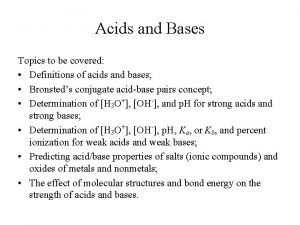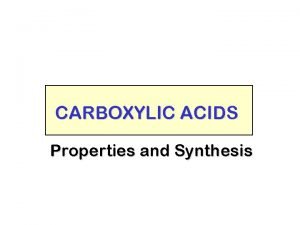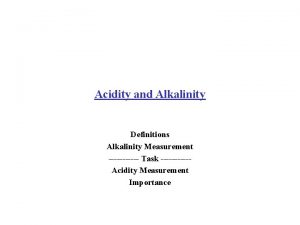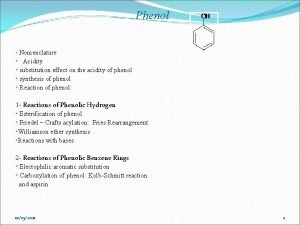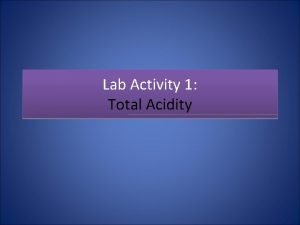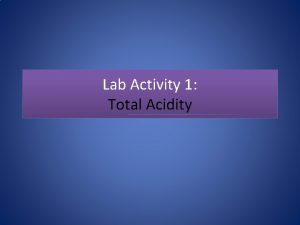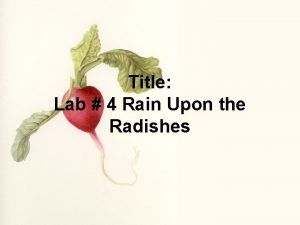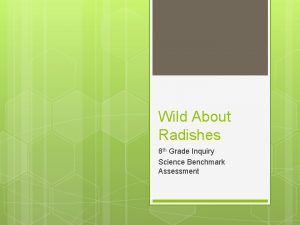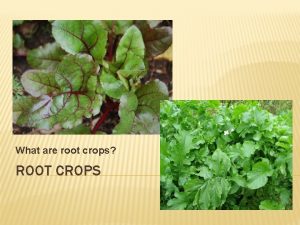Effects of Acidity on Radishes Kayleigh Magahan Frederick











- Slides: 11

Effects of Acidity on Radishes Kayleigh Magahan Frederick Styles Sofia Dinges

Research Question • How does different Ph levels in water affect the growth of radish seeds?

Background Research • Acid rain, or acid deposition, is a term referring to a mixture of wet and dry deposition from the atmosphere containing high amounts of nitric and sulfuric acids. - Wet deposition includes all forms of polluted precipitation; rain, snow, sleet, hail and fog. - Dry deposition refers to areas where the weather is dry. • Acid rain is a world-wide problem that effects our environment • Air pollution is what causes acid rain. • Top causes are car exhaust and factories that burn fuel, oil and coal. • Acid rain is measured by using the p. H scale. T

Hypothesis • We think that the radishes watered with lowest acidic level will grow the best. The radishes with the highest acidic levels will grow the least.

Materials • • • 3 growth chambers Soil Vernier Lab Quest Water Vinegar Ruler Radish Seeds Measuring Cups Beakers

Procedure • Create the growth chambers by cutting a water bottle in half and filling with 7 inches of soil each • Plant radish seeds about ½ to 1 inch deep in the soil • Measure the different levels of acidity by mixing vinegar and water. Use the Vernier Lab Quest to measure. Get all the levels to 7. 0, 5. 6, and 4. 5. • Put the three different solutions into different containers and label them to avoid confusion. • Water plant 1 with the neutral water (7. 0 Ph) Water plant 2 with 5. 6 Ph water. Water plant 3 with the 4. 5 p. H solution. Water each with 30 mg every other day. • Once the plants sprout, record the growth of each in a journal everyday by measuring the base of the stem to the tip. • After 3 weeks when the plants reach their full growth then compare all results and form conclusions.

Experiment Plant 7 Plant 4. 5 Plant 5. 6 Growth chamber in the early stage. Top view of the plants

Data Date October 17, 2011 Plant 1 (7 p. H) 5. 7 cm Plant 2 (5. 6) 8. 4 cm Plant 3 (4. 5) 4 cm October 19, 2011 7. 0 cm 8. 75 cm 6. 5 cm October 21, 2011 8. 1 cm 9. 25 cm 0 cm October 25 th, 2011 8. 5 cm 9. 45 cm 0 cm October 27 th, 2011 9 cm 9. 75 cm 0 cm 12 10 8 6 Plant 1 4 Plant 2 Plant 3 2 0 Day Day Day 1 3 5 7 9 11 13 15 17

Analysis • The first plant to sprout was the radish watered with the 5. 6 p. H solution, Plant 2. By Day 3 all of the plants had sprouted. They all grew rather fast, averaging about a centimeter a day, until about Day 7 - 10. At this point, Plant 1 and 2 started to grow only fractions of a centimeter every day. On Day 10, Plant 3 died. This was due to a malfunction of our equipment, which led to this plant being watered with a too acidic level.

Conclusions • After doing our experiment, our hypothesis was proven to be false. It turned out that the radishes watered with 5. 6 p. H water grew to be 9. 75 cm, while the 7 p. H level grew to be only 9 cm. The radishes watered with 4. 5 p. H ended up dying. Even though the radishes watered with a 5. 6 p. H grew the best, they did not turn out to be the most healthy. The 7 p. H radishes grew the most thick and sturdy. In conclusion, radishes watered with a low p. H level do not grow to be tall and radishes watered with an exact acid level to neutral grow to be tall.

Bibliography • "Acid Rain. " Acid Rain. Oracle Think-Quest. Web. 30 Oct. 2011. <http: //library. thinkquest. org/CR 0215471/acid_rain. htm>. • "What Is Acid Rain? | Acid Rain | US EPA. " US Environmental Protection Agency, 08 June 2007. Web. 30 Oct. 2011. <http: //www. epa. gov/acidrain/what/>. • "Acid Rain. " The Environment- A Global Challenge. Oracle Think Quest. Web. 30 Oct. 2011. < • http: //library. thinkquest. org/26026/Environmental_Problems/acid_rain. html>. • "Acid Rain Facts, Acid Rain Information, Acid Rain Pictures, Acid Rain Effects - National Geographic. " Environment Facts, Environment Science, Global Warming, Natural Disasters, Ecosystems, Green Living - National Geographic. Web. 30 Oct. 2011. <http: //environment. nationalgeographic. com/environment/globalwarming/acid-rain-overview/>.



